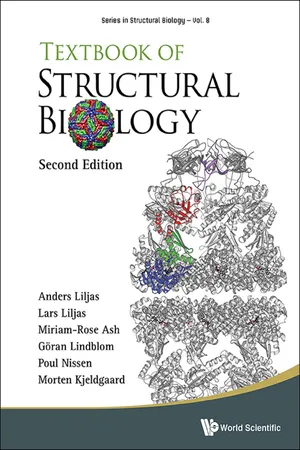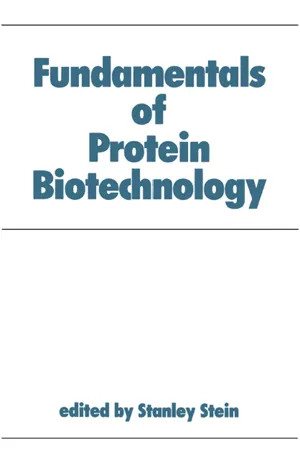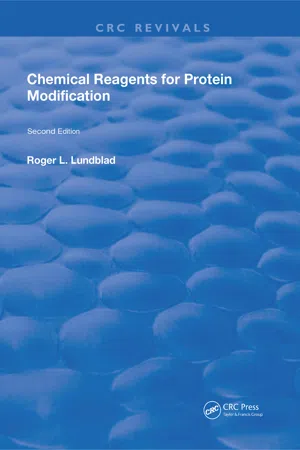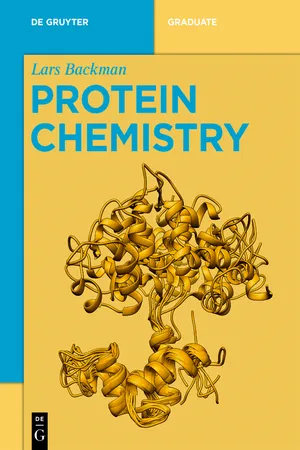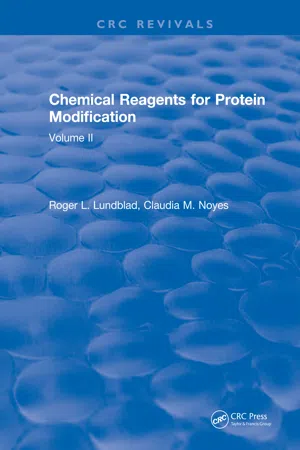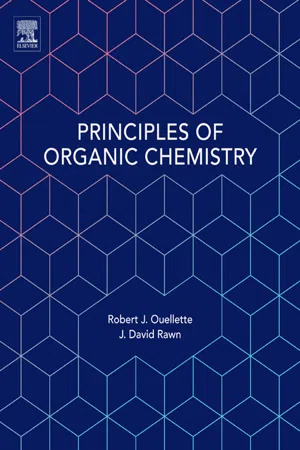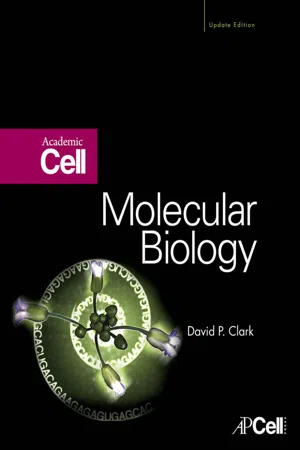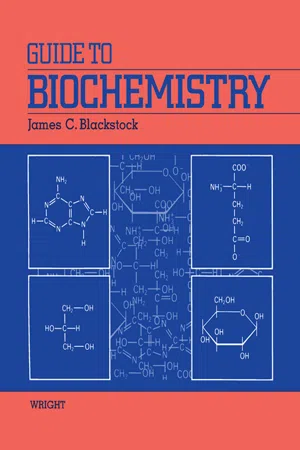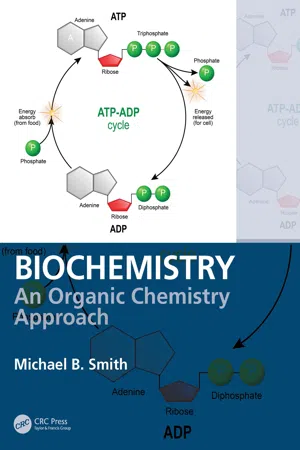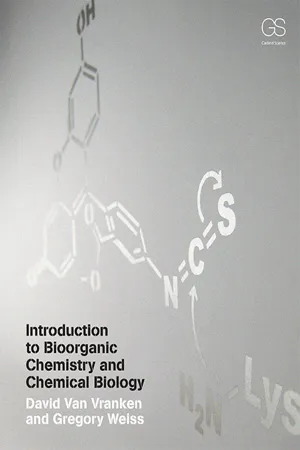Chemistry
Peptide Bond
A peptide bond is a covalent chemical bond that forms between the carboxyl group of one amino acid and the amino group of another amino acid during protein synthesis. This bond is formed through a dehydration reaction, resulting in the release of a water molecule. Peptide bonds are essential for linking amino acids together to form proteins.
Written by Perlego with AI-assistance
Related key terms
Related key terms
1 of 4
Related key terms
1 of 3
10 Key excerpts on "Peptide Bond"
- eBook - ePub
- Anders Liljas, Lars Liljas;Miriam-Rose Ash;G?ran Lindblom;Poul Nissen;Morten Kjeldgaard(Authors)
- 2016(Publication Date)
- WSPC(Publisher)
These are covalent bonds between the carbonyl carbon from one amino acid and the amino nitrogen from the next amino acid (Figure 2.5). Peptide Bond formation is catalyzed by the large ribosomal subunit (Chapter 11) and involves the liberation of one water molecule. In proteins and peptides, the free amino group of the first amino acid is called the N-terminus, and the free carboxyl group of the last amino acid is called the C-terminus. It is convention that protein sequences are always written from N-terminus to C-terminus, which is the order in which the protein is synthesized on the ribosome. The Peptide Bond between the CO and NH groups has a partial double bond character due to a resonance between the major form (~60%) and a form with a double bond between the C and N (~40%; Figure 2.6). Rotation about a double bond is not possible, and therefore the six atoms between two consecutive Cα atoms always lie in a plane called the peptide plane. Given the constraints of the peptide plane, there are only two possible orientations of the protein backbone around the Peptide Bond: (1) the trans configuration, in which consecutive Cα atoms lie on opposite sides of the Peptide Bond to each other (Figure 2.7, top), or (2) the cis configuration, in which they lie on the same side (Figure 2.7, bottom). These two conformations are described by the torsion angle (or dihedral angle) of the Peptide Bond, ω. When looking along the Peptide Bond, ω is the angle between the Cα-C bond from residue i and the N-Cα bond from residue i+ 1 (Figure 2.7). Therefore, the trans configuration will have ω = 180°, and the cis configuration ω = 0°. Fig. 2.5 ▪ Peptide Bond formation from two amino acids. The amino acids are shown here in their free zwitterionic forms, but when bound to tRNA on the ribosome both the amino and carboxyl groups are uncharged. The distances (in Å) and angles between the atoms of a Peptide Bond are shown in the bottom panel. Fig - eBook - ePub
- Stein(Author)
- 2017(Publication Date)
- CRC Press(Publisher)
An understanding of the relationship of a peptide or protein structure to its function is essential for the rational design of molecules with predicted properties that can be exploited for research and in the clinic. The chemical synthesis of peptides has a fundamental role in this area of modern biological research. Systematic variations in structure can be correlated with the properties of the resultant molecules; a direct approach to the identification of functional domains or of specific amino acids having specialized roles in the molecule of interest. These efforts are critically important since there is not yet a full appreciation of how the amino acid sequence of a peptide or protein directs its proper folding into a preferred bioactive conformation or a precise three-dimensional structure, giving rise to its unique properties. Macromolecular interactions, and the mechanisms governing biorecognition, particularly ligand/receptor interactions, must also be understood in order to design structures with predicted properties, and chemically synthesized peptides contribute to this goal as well. These and other applications of peptides have depended in large measure upon the accessibility of purified synthetic peptides ever since the first synthesis, in 1953, of a biologically active peptide hormone by du Vigneaud and his co-workers. The hormone was the cyclic octapeptide, oxytocin. Recent advances in the technology of chemical peptide synthesis, purification, and structural analysis have made such molecules more generally available, and the use of peptides in biomedical research and pharmaceutical development is expanding rapidly.BACKGROUNDThe term polypeptide was proposed in 1906 by Emil Fischer to describe structures consisting of variable numbers of amino acids linked together by amide bonds. The basic structural features of a linear peptide are illustrated in Figure 1 . A Peptide Bond is formed by a condensation reaction between two amino acids; the carboxyl group of one amino acid forms an amide bond with the amino group of a second amino acid, and a molecule of water is eliminated. The amino acids, which are called residues when they occur in peptide linkage, are conventionally numbered consecutively starting at the amino (N) terminus. The repetitive peptide backbone, which is all of the molecule except for the side-chain (R) groups, is defined by its length and by its direction. Each amino acid residue is distinguished by its side-chain moiety, which is attached to the alpha carbon atom (Fig. 1 - eBook - ePub
Chemical Reagents for Protein Modification
2nd Edition
- Roger L. Lundblad(Author)
- 2020(Publication Date)
- CRC Press(Publisher)
Chapter 15THE CHEMICAL CROSS-LINKING OF PEPTIDE CHAINS
The formation of either intramolecular or intermolecular covalent cross-links between amino acid residues in proteins is proving to be an extremely valuable tool in biochemistry with particular use in the study of protein-protein interactions. Naturally occurring inter-and intramolecular cross-links are commonly found in proteins, the most common being the disulfide bond. Other examples exist including the transglutaminase-catalyzed formation of a Peptide Bond between the γ-carboxyl groups of glutamic acid and the ϵ-amino groups of lysine.1 , 2 There are also the extremely complex cross-links found in collagen.3 , 4In addition to the study of protein-protein interactions, intramolecular cross-linking has been of value in increasing protein stability5-7 as well as stabilizing erythrocyte structure.8 Cross-linking between a biologically active protein and a carrier protein has been advocated for therapeutic purposes9 although this approach will likely be supplanted by the preparation of chimeric proteins. Covalent cross-linking with the reagents described in this chapter have been used to complex peptides to carrier proteins such as hemocyanin or tetanus toxin for the preparation of antipeptide antibodies.10 Care must be exercised in the screening of antibodies resulting from the use of peptide-carrier conjugates not only for cross-reactivity with the carrier protein but also for antibodies directly to coupling groups used in such procedures.11Zero-length cross-linking12 is a procedure which joins peptide chains via existing functional groups such that a “spacer” group is not utilized. Examples include the covalent linkage of proteins to nucleic acids, the formation of 3,3’-dityrosine mediated by tetranitromethane (see Chapter 13 ) and isoPeptide Bond formation. IsoPeptide Bond formation (Figure 1 ) mediated by carbodiimide13 , 14 (see Chapter 14 ) has been the most extensively used approach. This technique has been applied to the cross-linking of heavy meromyosin and F-actin15 , 16 and components of the A. vinelandii nitrogenase complex.17 A more recent modification of this technique18 involves a two-step procedure where one protein is first incubated with a water-soluble carbodiimide and N -hydroxysuccinimide resulting in the formation of an N - eBook - ePub
- Lars Backman(Author)
- 2019(Publication Date)
- De Gruyter(Publisher)
Figure 4.2 ). The order amino acids condensate is coded into the mRNA and tRNA carries an activated amino acid (attached by an ester coupling) to the ribosome. The synthesis is error free, does not produce unwanted products and can produce very large protein containing several thousands of amino acid residues. Although it is possible to chemical synthesize proteins (by solid-phase processes), it is not feasible to produce long (> 100 residues) error-free proteins.Figure 4.2: Peptide Bond formation. (a) Schematic reaction mechanism of condensation of two amino acids and the loss of a water molecule. The Peptide Bond can be hydrolyzed by certain enzyme, proteases. (b) The Peptide Bond is stabilized by delocalization of the lone pair of the nitrogen to the carbonyl, giving the bond between the nitrogen and carbonyl carbon a partial double bond character.4.1 The Peptide Bond
The delocalization of the lone pair electrons of the nitrogen to the carbonyl gives the Peptide Bond ca. 40% double bond character (Figure 4.2B ). The bond length between the Peptide Bond’s carbonyl carbon and amide nitrogen (1.33 Å) is therefore shorter than a single-carbon nitrogen bond (1.47 Å) but longer than a double-carbon nitrogen bond (1.27 Å). A planar conformation of the six atoms (carbonyl carbon and oxygen, and amide nitrogen and hydrogen as well as the two α-carbons) involved in the peptide group is most stable (Figure 4.3 ).Figure 4.3: A trans Peptide Bond. Structural dimensions of average bond lengths and angles are based on X-ray crystal data from C. Ramakrishnan and G.N. Ramachandran (1965) Stereochemical criteria for polypeptide and protein chain conformations. II. Allowed conformations for a pair of peptide units. Biophys. J. 5:909–933, R.A. Engh and R. Huber (1991) Accurate bond and angle parameters for x-ray protein-structure refinement. Acta Cryst. A 47:392–400 and A. Jabs, M.S.Weiss and R. Hilgenfeld (1999) Non-proline cis Peptide Bonds in proteins. J. Mol. Biol. 286:291–304.The partial double bond character of the peptide has a very important structural role. There are two possible conformations of the Peptide Bond; the carbonyl oxygen and the amide proton can be in a trans or cis conformation (Figures 4.3 and 4.4 ). As it turns out, nearly all Peptide Bonds are in the trans conformation. It is estimated that only around 0.05% of nonproline Peptide Bonds are cis, while around 6% of X-Pro Peptide Bonds are cis. Due to the double-bond character, there is a rather high energy cost to change the conformation of a cis Peptide Bond, and particularly of a nonproline cis Peptide Bond, to trans - eBook - ePub
- Roger L. Lundblad(Author)
- 2018(Publication Date)
- CRC Press(Publisher)
Chapter 5THE CHEMICAL CROSS-LINKING OF PEPTIDE CHAINS
The formation of either intramolecular or intermolecular covalent crosslinks between amino acid residues in proteins is proving to be an extremely valuable tool in biochemistry with particular use in the study of protein-protein interactions. Naturally occurring inter-and intramolecular crosslinks are commonly found in proteins, the most common being the disulfide bond. Other examples exist including the transglutaminase-catalyzed formation of a Peptide Bond between the 7-carboxyl groups of glutamic acid and the e-amino groups of lysine.12 There are also the extremely complex crosslinks found in collagen.3 , 4The formation of and subsequent determination of the sites of intrachain or interchain covalent crosslinks provide a direct approach to the study of the folding and interaction of polypeptide chains in solution. A number of important questions can be addressed through the introduction of covalent crosslinks into a protein. The formation of intramolecular crosslinks within a single polypeptide chain can provide information regarding inter-residue distances and the relationships between various domains in a protein. Care must be used in the interpretation of such results with respect to the effect of such cross-linking on catalytic function or biological function. In order to draw meaningful conclusions one must know the effect of the reaction of amino acid residues with monofunctional analogues of the bifunctional reagent. In other words, derivatives formed by the reagent X-R-R-X or X-R-R-Y should be compared with the reaction products of RY and/or RX with the same residue(s).One of the more interesting examples of intramolecular cross-linking has involved the use of 1,3-dibromoacetone (Figure 1 ). Either methylene carbon would be subject to nu-cleophilic attack. Husain and Lowe5 obtained intramolecular cross-linking between the active site cysteine and the active site histidine in ficin and stem bromelain. These results suggested that the histidine residue is with 5Á of the active site cysteine. No intermolecular cross-linking occurred under the reaction conditions used by these investigators (0.05 M sodium acetate, 0.0001 M EDTA, pH 5.6; the dibromoacetone was dissolved in acetone). Spatial proximity is of critical importance since treatment of glyceraldehyde-3-phosphate dehydrogenase with 1,3-dibromoacetone resulted in the modification of cysteine but not histidine.6 - eBook - ePub
- Robert J. Ouellette, J. David Rawn(Authors)
- 2015(Publication Date)
- Elsevier(Publisher)
native conformation. Protein structure is described at four levels: primary, secondary, tertiary, and quaternary. Each of these divisions is somewhat arbitrary because it is the total structure of the protein that controls function. Nevertheless, it is useful to consider the levels of structure individually, so we will proceed by describing each level of structure in turn.Primary Structure
The linear sequence of amino acids in a protein and the location of disulfide bonds is called its primary structure. The Peptide Bond, which is largely responsible for the primary structure of a protein, is a very strong bond. The Peptide Bond is a resonance hybrid of two contributing structures, and the carbon-nitrogen bond has partial double bond character. The Peptide Bond is planar, and there is restricted rotation about the carbon-nitrogen bond.Two conformations are possible about the planar Peptide Bond. The trans conformation shown for the amide bond of N-methylacetamide is more stable than the alternate cis conformation due to steric effects (Figure 14.6 ). The amino acid residues in proteins usually exist in such trans conformations as well for the same reason.Figure 14.6 Structure of the Peptide Bond(a) Rotation around the C—N bond, which has 50% double bond character, does not occur at room temperature. However, rotation around the N—Ca bond (ϕ) and the C—Ca bond (ψ) is possible, and many conformations are possible in peptides and proteins.(b) We can think of the α-carbon as a “hinge” between two planar Peptide Bonds. If one takes two note cards, and links them with a swivel, it is easy to see that many arrangements are possible. However, some ϕ and ψ are not possible because of steric interference of the side chain R group. Glycine, for example, can assume many more conformations than amino acids like proline and tryptophan.The bond between the α-carbon atom of peptides and the carbonyl carbon atom is a rotationally free single bond. Similarly, the single bond between the nitrogen atom and the α-carbon atom of the next amino acid is also rotationally free. There is, in addition, free rotation about the bonds between the α-carbon atoms and the R groups. Thus, a protein chain consists of rigid peptide units connected to one another by freely rotating single bonds. - eBook - ePub
- David P. Clark(Author)
- 2009(Publication Date)
- Academic Cell(Publisher)
Fig. 7.05 ). The polypeptide chain must be folded around to bring two peptide groups alongside each other. The hydrogen on the nitrogen of one peptide group is then bound to the oxygen of the other. [Note that hydrogen bonds also contribute to tertiary structure, but here they are not the only or even the major forces involved.]Figure 7.05 Hydrogen Bonding between Peptide Groups Two Peptide Bonds of a polypeptide chain may be aligned to form a hydrogen bond by looping the polypeptide chain around.Most of the secondary structure found in proteins is due to one of two common secondary structures, known as the α- (alpha) helix and the β- (beta) sheet . Both structures allow formation of the maximum possible number of hydrogen bonds and are therefore highly stable.alpha- (α-) helix A helical secondary structure found in proteins β- (beta-) sheet A flat sheet-like secondary structure found in proteins cofactor Extra chemical group bound (often temporarily) to a protein but which is not part of the polypeptide chain primary structure The linear order in which the subunits of a polymer are arranged prosthetic group Extra chemical group bound (often covalently) to a protein but which is not part of the polypeptide chain quaternary structure Aggregation of more than one polymer chain to form a final structure secondary structure Initial folding up of a polymer into a regular, repeating structure, due to hydrogen bonding tertiary structure Final 3-D folding of a polymer chain In the α-helix (Fig. 7.06 - eBook - ePub
- James C. Blackstock(Author)
- 2014(Publication Date)
- Butterworth-Heinemann(Publisher)
Figure 4.3 ). Hydrogen bonds involving Peptide Bond atoms although individually weak are responsible for the fundamental ordered shapes of the second level of protein structure described as secondary structure. Hydrogen bonds between Rgroup atoms along with ionic bonds, hydrophobic interactions and disulphide bonds within a polypeptide chain, i.e. intramolecular bonds, contribute to the stability of the protein structure at the third level described as tertiary structure. The types of bonds which maintain the tertiary structures of proteins excluding disulphide bonds are also responsible for the spatial arrangement of protein subunits through intermolecular bonding. This is the fourth level of protein structure described as quaternary structure.FIGURE 4.3 Hierarchy of protein structure indicating the forms of bonding found at each levelTwo amino acids may link together by a condensation reaction in which one donates its carbonyl group and the other an amino group to form a Peptide Bond. One end of the dipeptide exhibits a free amino group and is called the N -terminus. The other end exhibits a free carboxyl group and is called the C -terminus.The geometry of the Peptide Bond (Figure 4.4a ) is important. The C–N bond length in the Peptide Bond is shorter than the 0.145 nm recorded for a single covalent C–N bond. This is a result of the propensity of the oxygen atom to withdraw electrons. The electrons associated with the C–N bond and the C=O group resonate between two structures (Figure 4.4b ) to create a partial double bond character (about 40%) for the C–N single bond and an equal partial single bond character for the C=O double bond. As a result of resonance stabilization, the rotation of the C–N single bond is restricted so that six atoms are rigidly positioned in the same plane (i.e. are coplanar) and the bond has a trans configuration. Because proteins are composed of only L -amino acids, the R group on each of the Cα atoms are arranged on opposite sides of the backbone. This arrangement minimizes steric interaction of bulky R groups (Figure 4.4c, d ). Since the imino group (N–H) of the Peptide Bond has no significant tendency to protonate at physiological pH. The ionic properties of a protein are the result of only R group ionizations and those of the N -terminal amino and C -terminal carboxyl groups. Although the Peptide Bond cannot rotate freely, the Cα atom serves as a pivot on which the coplanar groups may rotate (Figure 4.5 - eBook - ePub
Biochemistry
An Organic Chemistry Approach
- Michael B. Smith(Author)
- 2020(Publication Date)
- CRC Press(Publisher)
12 Peptides and ProteinsPolymeric chains of amino acids are peptides, and proteins are poly(peptides). Proteins are essential to living systems and the critically important proteins called enzymes catalyze processes that are essential to life. This chapter will discuss peptides, their characteristics and how they are formed. In addition, the structure and function of proteins will be discussed.12.1 Reactions and Synthesis of α-Amino Acids
Amino acids undergo several important reactions that are dominated by the amine group and/or the carboxyl group. The fact that the amine and the carboxyl react with each other complicates things, because one functional group will influence the reactivity of the other. The conversion of a simple carboxylic acid to an ester is quite easy, either by reaction of the carboxylic acid with an alcohol under acidic conditions, or by first converting the acid to an acid chloride and subsequent reaction with an alcohol. However, amines also react with acid chlorides or with esters to yield the corresponding amide. In other words, trying to form an ester in the presence of an amine may be a problem. To target one functional group in an amino acid, the other must be taken into account and usually blocked (protected) with a functional group that can be removed after the planned reaction.The carboxylic acid group of an amino acid can be converted to an ester by reaction with an alcohol in the presence of aqueous acid. Using the zwitterion form of alanine as an example, treatment with acid generates the protonated form, (1S )-carboxyethanaminium. Subsequent reaction of aqueous ethanol and an acid catalyst converts the COOH unit to the corresponding ester of alanine. The amine unit exists as its ammonium salt in the aqueous acid medium.The amine unit of an amino acid can be functionalized. Reaction of the amine group of alanine was treated with trifluoroacetic anhydride and pyridine to give the N-trifluoroacetamide derivative.1 If desired, the COOH unit can be functionalized and the COCF3 unit can easily be converted back to the amine by reaction with K2 CO3 in aqueous methanol. As shown for aspartic acid, the distal carboxyl group can be converted to the methyl ester by reaction with thionyl chloride and then methanol. Subsequent reaction with benzyl carbonochloridate (benzyloxy chloride; Cbz-Cl) gives the corresponding N- carbobenzoxyl or N-Cbz derivative.2 - David Van Vranken, Gregory A. Weiss(Authors)
- 2018(Publication Date)
- Garland Science(Publisher)
Peptide and Protein Structure 5Learning Objectives
- Become fluent in the basic vocabulary of protein structure: the common ribosomal amino acids and their one-letter codes.
- Recognize hydrophobic interactions as a major contributor to protein folding and binding.
- Learn the chemical mechanisms upon which chemical peptide synthesis is based.
- Understand the elementary chemical forces that control protein conformation.
- Distinguish patterns of hydrogen bonding that distinguish helices, sheets, and turns.
- Associate amino acids with canonical secondary structure preferences.
- Recognize hierarchical structural patterns in folded proteins.
R eflecting the centrality of proteins in biology, their name is derived from the Greek word πρωτειοσ, which means “of primary importance.” In 1838 the Dutch chemist Gerrit Jan Mulder conferred this name to recognize the requirement for proteins in the diet of animals. Berzelius later found that all proteins have similar empirical formulas. Proteins are oligomers of amino acids joined together by amide bonds. Composed of 20 different building blocks, proteins display a much more varied array of functional groups and structures than either DNA or RNA, which have only four building blocks each. For DNA, structure came first; sequencing came later. The opposite is true for proteins because a process known as the Edman degradation method made it possible to elucidate the sequence of amino acid residues in proteins long before the first protein structures were determined.The amide backbone of proteins offers greater hydrogen-bonding capacity than any other polymer backbone. To satisfy this demand for hydrogen bonding while facilitating hydrophobic interactions, proteins fold into a wide array of well-defined shapes. The ability to fold into specific shapes, displaying a wide range of chemical functionality, makes proteins far more versatile than oligonucleotides. Indeed, proteins serve as catalysts, force-transducing machines, cellular gatekeepers, structural materials, and environmental sensors; they also have hundreds of other key roles in the cell.
Index pages curate the most relevant extracts from our library of academic textbooks. They’ve been created using an in-house natural language model (NLM), each adding context and meaning to key research topics.
Explore more topic indexes
Explore more topic indexes
1 of 6
Explore more topic indexes
1 of 4
